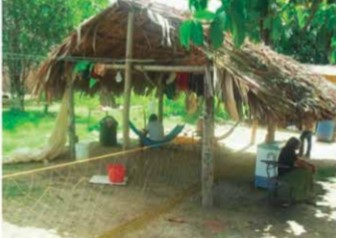Social situation of artisanal fishermen from the Moriche, El Guamal and Isla Misterios communities, Delta Amacuro state
Abstract
The history of fishing is the history of man himself, since the origins of civilization, it is a subsistence activity, characterized by collection and no instrumentality, giving way to artisanal fishing, which has developed with the incorporation of fishing gear and technological advances, optimizing catches and making their extraction more vertiginous (Morán-Angulo, 2008). For Cifuentes-Lemus and Cupul-Magaña (2002), from very ancient times the Egyptians, Hebrews, Assyrians and Phoenicians practiced fishing in the Mediterranean. In America and in Mexico in particular, ancient manuscripts show that fishing was practiced before the arrival of the Spanish.
The fishing methods and gear used have remained practically unchanged since colonial times (16th to 18th centuries). The only real major innovation was the introduction of diesel and outboard engines in the early 1930s (Méndez-Arocha, 1963). In this regard, Oldepesca (2009) points out that in artisanal or small-scale fishing, in Latin America and the Caribbean, more than 2 million fishermen participate, reaching a level of production greater than 2.5 million tons and values of approximately US $ 3,000 million; However, the artisanal fishing communities of that region present a poverty of a multidimensional nature, originated by technological factors (methods and levels of capture), socio-cultural and institutional context and a scarce political representation that aggravates social and economic marginalization.
The history of fishing is the history of man himself, since the origins of civilization, it is a subsistence activity, characterized by collection and no instrumentality, giving way to artisanal fishing, which has developed with the incorporation of fishing gear and technological advances, optimizing catches and making their extraction more vertiginous (Morán-Angulo, 2008). For Cifuentes-Lemus and Cupul-Magaña (2002), from very ancient times the Egyptians, Hebrews, Assyrians and Phoenicians practiced fishing in the Mediterranean. In America and in Mexico in particular, ancient manuscripts show that fishing was practiced before the arrival of the Spanish.
The fishing methods and gear used have remained practically unchanged since colonial times (16th to 18th centuries). The only real major innovation was the introduction of diesel and outboard engines in the early 1930s (Méndez-Arocha, 1963). In this regard, Oldepesca (2009) points out that in artisanal or small-scale fishing, in Latin America and the Caribbean, more than 2 million fishermen participate, reaching a level of production greater than 2.5 million tons and values of approximately US $ 3,000 million; However, the artisanal fishing communities of that region present a poverty of a multidimensional nature, originated by technological factors (methods and levels of capture), socio-cultural and institutional context and a scarce political representation that aggravates social and economic marginalization.
References
FAO. 2007. Fundación para la Superación de la Pobreza, 1999.Visión del sector pesquero artesanal. Base de una propuesta para su desarrollo. Tomo II.
Méndez-Arocha, A., 1963. La pesca en Margarita. Monografía Nº 7. Fundación la Salle de Ciencias Naturales. Caracas-Venezuela.
Moran Angulo, R. E. 2008. “La pesca un leve análisis desde la acción instrumental”, en revista Sinaluense de ciencias sociales de la Universidad Autónoma de Sina.
Novoa, D. 2000. La pesca artesanal comercial en los alrededores de Isla de La Tortuga Venezuela. Memoria Fundación La Salle de Ciencias Naturales. Tomo LX. Número 153.Enero/junio 2000.
Oldepesca. 2009. Pesca Artesanal. http://www.oldepesca.com/node/89. (Fecha de consulta: 23 de enero del 2013).


